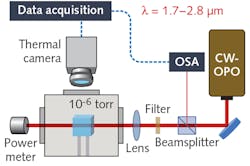Laser Cooling: Thulium-doped fluoride crystals offer potential for mid-IR optical cryocooling
All-optical cryogenic cooling of macroscopic devices has come a long way. Last year, a group of researchers at Los Alamos National Laboratory (LANL; Los Alamos, NM) and the University of New Mexico (UNM; Albuquerque, NM), headed by Mansoor Sheik-Bahae of UNM, reported on laser-cooling a ytterbium-doped fluoride (Yb:YLF) crystal and, more importantly, an attached HgCdTe optical sensor to 134.9 K.1 Such a nonmechanical setup could be used, for example, on an imaging satellite for which the vibration resulting from a mechanical cooler would degrade image capture by the satellite.
Bahae and colleagues from LANL, UNM, and the Università di Pisa (Pisa, Italy) have been working on the use of other crystals for laser cooling as well, including the thulium-doped fluoride crystals Tm:YLF and Tm:BYF, and the holmium-doped crystal Ho:YLF. They have now demonstrated for the first time optical refrigeration in Tm:YLF crystals and have measured room-temperature laser-cooling efficiencies for Tm:YLF and Tm:BYF crystals.2
As the high-purity crystals required are not available commercially, the group had the crystals custom-grown—the Tm:YLF by AC Materials (Tarpon Springs, FL) and the Tm:BYF at the Università di Pisa. To measure room-temperature cooling efficiency, an optical parametric oscillator (OPO) light source was tuned from below to above the optimum cooling wavelength and the laser-induced temperature change measured—the experiment was carried out in vacuum and the crystal was supported by holders that conducted very little heat away (see figure). The temperature change was normalized to the power absorbed to find the cooling efficiency, and different molar doping concentrations and polarizations were tested.
Potential cooling to 110 K
The optimum cooling wavelength ranged between 1857 and 1910 nm for different crystals at room temperature, with a small red shift for cooler temperatures. The global minimum achievable temperature (MAT) was estimated for each of the crystals: for 1% Tm:YLF and 2% Tm:YLF, the MAT was 190 K and 180 K, respectively, and for 2% Tm:YLF, 1% Tm:BYF, and 1% Tm:BYF, the MAT was 160 K for all three. The estimated MATs could be improved by higher doping or by reducing the crystals’ background absorption by using purer crystals. Taking these potential changes into account, the researchers estimate a MAT for 2% Tm:YLF and 1% Tm:BYF of about 110 K at wavelengths of 1929 and 1926 nm, respectively.
Thus, both crystals could be used for mid-IR optical cryocoolers. In addition, because the Tm:BYF crystal has the same MAT and wavelength for both polarizations, the crystal does not need a polarized light source.
The researchers also discuss the possibility of using the laser-cooling crystals as the gain medium for so-called radiation-balanced lasers (RBLs), in which optical cooling in the gain medium carries away the heat produced by laser inefficiencies—an arrangement that theoretically enables scaling of lasers to very high powers. Such lasers (at low power) have already been demonstrated using Yb:YAG crystals, including by Bahae’s group. The new research opens up the possibility of mid-IR Tm:BYF-based RBLs. Alternatively, a “two-tone” RBL could be made, in which a Tm-doped cooling crystal is placed next to a holmium-doped laser crystal.
REFERENCES
1. M. P. Hehlen et al., Light Sci. Appl., 7, 15 (2018); https://doi.org/10.1038/s41377-018-0028-7.
2. S. Rostami et al., Opt. Lett. (2019); https://doi.org/10.1364/ol.44.001419.
About the Author
John Wallace
Senior Technical Editor (1998-2022)
John Wallace was with Laser Focus World for nearly 25 years, retiring in late June 2022. He obtained a bachelor's degree in mechanical engineering and physics at Rutgers University and a master's in optical engineering at the University of Rochester. Before becoming an editor, John worked as an engineer at RCA, Exxon, Eastman Kodak, and GCA Corporation.

